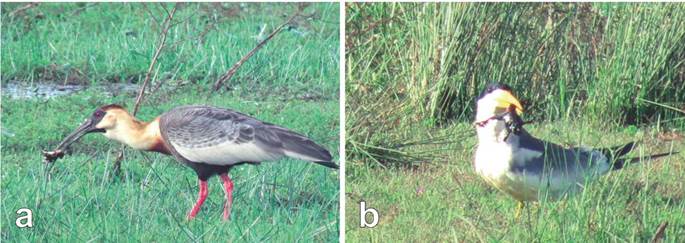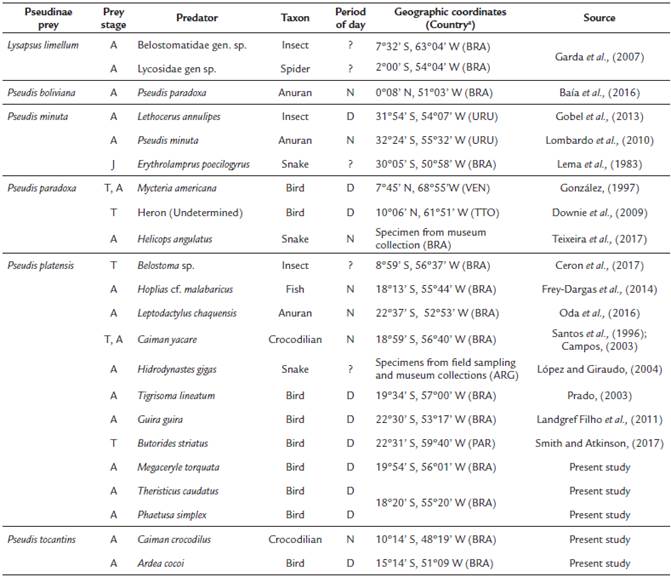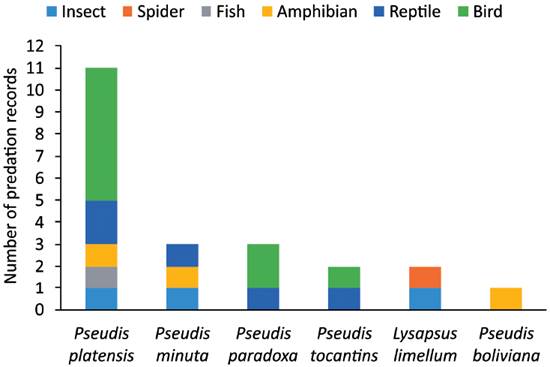Neotropical amphibians play important roles in freshwater and terrestrial ecosystems, contributing to different ecological functions (Cortés-Gomez et al., 2015), one of the most important of which is their dual role in the food web, acting as prey and predator for a wide variety of invertebrates and vertebrates (Toledo, 2005; Toledo et al., 2007). Anuran species are abundant and conspicuous during the breeding season when adult and newly-metamorphosed individuals are more susceptible to becoming prey items for aquatic and terrestrial predators (Toledo, 2005; Toledo et al., 2007). Thus, predation is an important biotic process that affects the distribution and structure of amphibian communities (Morin, 1983, 1986; Hamer and Parris, 2013).
The subfamily Pseudinae (Fitzinger, 1843) includes small and medium-sized frogs within three genera and representing 13 valid species distributed in tropical and subtropical South America east of the Andes, including Trinidad southward to Uruguay, Paraguay, and northern Argentina (Duellman et al., 2016; Frost et al., 2018). Most published records of predation on Pseudinae frogs are anecdotic and scarce (see Toledo, 2005; Toledo et al., 2007). Therefore, knowledge of new cases may improve our understanding of predator-prey relationships among these frogs and their role in the food web. Moreover, there is no compilation of recent predation records of Pseudinae frogs in South America. Herein, we reported five cases of predation on two Pseudinae frog species by a crocodilian and four aquatic bird species. We also present a list with invertebrate and vertebrate predators of six Pseudinae species, reviewed from available literature on predation of amphibians in South America.
New predation records for Pseudinae species were obtained from field observations performed during anuran surveys at a locality in Tocantins state (municipality of Palmas), a location in Goiás state (municipality of Britânia), and two localities in Mato Grosso do Sul state (municipalities of Aquidauana and Corumbá), northern and central Brazil, respectively. Voucher specimens were anesthetized with 5 % lidocaine, fixed in 10 % formalin, preserved in 70 % ethanol, and housed at the Zoological Reference Collection of the Universidade Federal de Mato Grosso do Sul - Amphibia (ZUFMS - AMP).
Unpublished data (i.e., new predation records) as well as articles and natural history notes published in Herpetozoa (from 1988 to the 31th volume of 2018), Herpetological Review (from 1967 to the fourth volume of 2018), Herpetological Bulletin (from 2008 to the 145st issue of 2018), and Herpetology Notes (from 2008 to the 11th issue of 2018) were considered in the present review. These journals were selected due to their specialized sections on natural history notes. We also carried out a bibliographic search in Web of Science on December 13th, 2018, considering all years and not applying any filters. The search terms were ("predation" OR "prey") AND ("Lysapsus" OR "Pseudis" OR "Scarthyla"). As we were interested in predation events in the field, predation events in laboratory experiments and captivity were not considered. We also did not include records of predation attempts, since such occurrences would not necessarily result in a predation event (Toledo et al., 2007).
In the municipality of Palmas, we observed a juvenile Caiman crocodilus preying on an adult Pseudis tocantins on 11 November 2000 at 22:10 h in a flooded lagoon of the Tocantins River. In the municipality of Britânia, we observed an adult Ardea cocoi preying on an adult P. tocantins on 08 February 2003 at 10:00 h in a swampy area. Brandão and Peres Jr., (2001) observed several times individuals of Pseudis tocantins on large and vegetated permanent ponds during a long-term herpetofaunal inventory in the Tocantins river valley, between the cities of Porto Nacional and Palmas, Tocantins state. Nevertheless, predation events were not observed in the study site (RA Brandão, personal communication). Furthermore, there are no reported cases of predation on Pseudis tocantins in the available literature. The predation of C. crocodilus and A. cocoi on P. tocantins are the first records of predation for this Pseudinae species.
During fieldworks in two farms in southern Pantanal wetland, Mato Grosso do Sul state, Brazil; we recorded three cases ofpredation on Pseudisplatensis. On 2nd November 2011 in a swampy area at "Fazenda Retirinho" in the municipality of Aquidauana (19°54' S, 56°01' W), we observed an adult Megaceryle torquata preying on an adult P. platensis. The bird was on a barbed wire fence and saw the frog in a temporary puddle. At that time, the bird flew toward the water body, where captured the frog, and returned to barbed fence post holding it in its beak. The frog was killed by being beaten against the fence post. When disturbed by our presence the bird flew away. On 29th May 2013 in a swampy area at "Fazenda Tupã" in the municipality of Corumbá (18°20' S, 55°20' W), we observed an adult Theristicus caudatus and an adult Phaetusa simplex preying on two individuals of P. platensis (Fig. 1a - 1b). Records on predation of P. platensis by birds are scarce. Among these, only three species -Tigrisoma lineatum, Guira guira, and Butorides striatus - have been reported as predators of adults and tadpoles of Pseudis platensis (Prado, 2003; Landgref Filho et al., 2011; Smith and Atkinson, 2017). Therefore, Megaceryle torquata, Theristicus caudatus, and Phaetusa simplex are new predators of P. platensis.

Figure 1 Theristicus caudatus (a) and Phaetusa simplex (b) holding specimens of Pseudis platensis in swampy areas in southern Pantanal wetland, state of Mato Grosso do Sul, central Brazil. Photos: Edivaldo Oliveira de Souza.
We recovered 22 predation events from the literature reviewed, which were reported in 15 studies published between 1983 and 2017 (Table 1). Considering all events, six Pseudinae species - Lysapsus limellum, Pseudis boliviana, P. minuta, P. paradoxa, P. platensis, and P. tocantins - have been reported as prey of 21 predator taxa, including nine birds, four reptiles, three amphibians, three insects, one fish, and one spider (Table 1, Fig. 2). Pseudis platensis had the highest number of predation events, with 11 reported cases. Of these, 72 % (n = 8) were recorded in Brazil (Table 1). In a literature review on invertebrate predators of anurans, Toledo, (2005) found no records of predation on Pseudinae frogs. Toledo et al., (2007) conducted a detailed review on post-metamorphic anurans as preys of vertebrates and considered unpublished data as well as only articles and natural history notes published in Herpetological Review. The authors found only two predation event records for Pseudinae frogs, both for P. platensis (Santos et al. , 1996; Prado, 2003). In the present study, we considered articles and natural history notes published in four herpetological journals, unpublished data, and additional references searched in the Web of Science. This diversified data source increased the information in this review, improving the knowledge available on predators of Pseudinae frogs. However, we found that only 46 % of the Pseudinae species known in South America have been reported as prey items of invertebrate and vertebrate predators. Among these species, five belong to the genus Pseudis, demonstrating that much is yet to be understood regarding predator-prey interactions for most Pseudinae species, especially species of Lysapsus and Scarthyla.
Table 1 Invertebrates and vertebrates identified as predators of Pseudinae frogs in South America. Prey stage: A - adult, J - juvenile, T - tadpole. Period of day: D - day, N - night, ? - data not available.

aARG, Argentina; BRA, Brazil; PAR, Paraguay; TTO, Trinidad and Tobago; URU, Uruguay; VEN, Venezuela.
The higher number of predation events reported for Pseudis platensis may be due to its wider geographic distribution in Bolivia, Paraguay, Argentina and Brazil (Frost et al., 2018). Likewise, Brazil is the largest country in South America and thus have greater research efforts (in the absolute number of researchers) than other countries in the region (Van Noorden, 2014).
Pseudinae species have both diurnal and nocturnal activity (see Brandão et al., 2003; Ávila and Ferreira, 2004). They are exposed to a different set of predators in each period, such as visually oriented predators during daytime and movement-sensitive predators at night, which influence its activity patterns and behaviors, especially in the breeding season (Lima and Dill, 1990; Garda et al., 2007; Buxton and Sperry, 2016). Among the most important vertebrate predators of amphibians are the birds (Polin et al., 2001). In the present study, adult frogs were preyed upon more frequently than juveniles and tadpoles. Diurnal and visually oriented predators were the majority, with birds accounting for most records (90 % of the predation events recorded with diurnal predators alone). Except for Guiraguira, all avian predators in this study are wading birds. They are considered as convenience predators, but foraging in environments inhabited by Pseudis and Lysapsus and feed on them with regularity in nature (González, 1997; Toledo et al., 2007).
The higher abundance of Pseudinae species can make these common preys for amphibians and reptiles, mainly crocodilians and aquatic snakes (López and Giraudo, 2004; Toledo et al., 2007; Oda et al., 2016), with even the occurrence of cannibalistic events (Lombardo et al., 2010).
Although few predation events of Pseudinae species by other amphibians and reptiles have been published; we believe that the interaction between them also occur with frequency as reported for birds. A variety of invertebrates prey on anurans, but water bugs and spiders are the most common predators (Toledo, 2005). In the present study, water bugs accounting for most records (75 % of the predation events recorded with invertebrate predators alone). However, events of anuran predation by invertebrates remain poorly documented, and it is probable that such events are more difficult to record since it is necessary to observe the moment of predation. In contrast, predation events can be determined for vertebrates through the analysis of the digestive tract (Pombal Jr., 2007).
Predation is a key factor in community structure, directly affecting trophic relationships among species and, consequently, species coexistence (Chase et al., 2002; Morlon et al., 2014). As important prey items for invertebrates and vertebrates, amphibians contribute to ecosystem structures, energy pathways and food webs (Hocking and Babbitt, 2014). However, trophic relationships are rarely observed in the field and poorly documented, especially in tropical ecosystems (Poulin et al., 2001). Understanding trophic links require recording a significant subset of a predator-prey assemblage and are essential to understanding food webs.
This study presents important data on the predation of Pseudinae frogs by invertebrates and vertebrates in South America. For most Pseudinae species there are no reports of predation, especially species of Lysapsus and Scarthyla. The Pseudinae species with a higher number of predation events reported was Pseudis platensis. Birds and water bugs accounting for most predation records among the vertebrates and invertebrates, respectively. However, events of anuran predation by invertebrates remain poorly documented because are more difficult to record. Thus, the description of new cases of predation accompanied by a review of the data available in the literature is crucial to understanding Neotropical food webs.
















